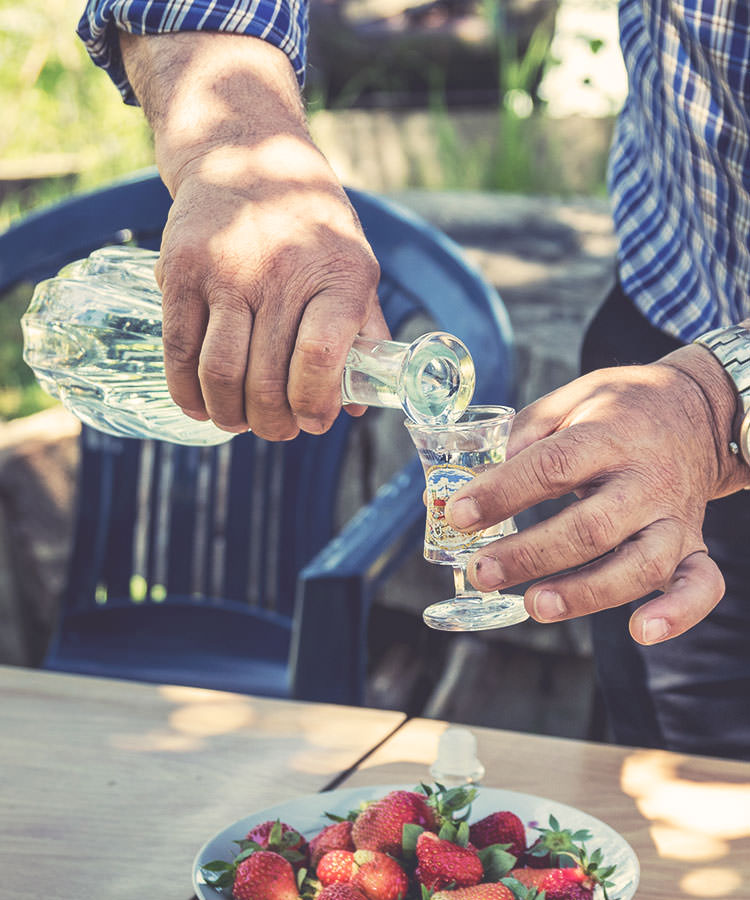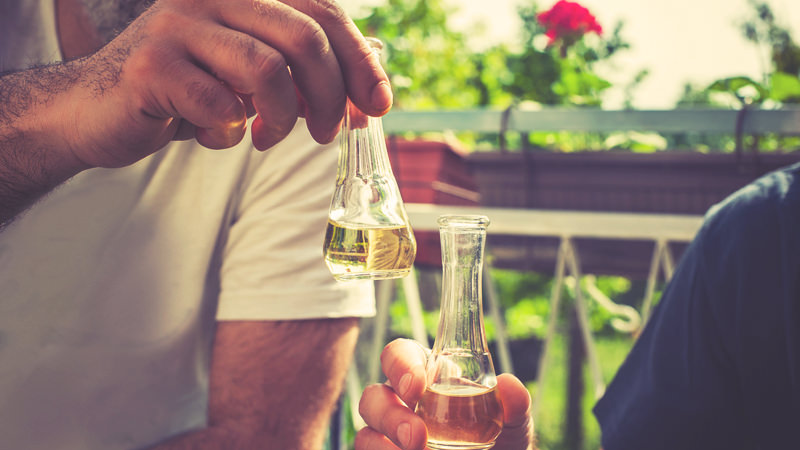Across the verdant but troubled Balkan peninsula, raki is the fuel of the common man and woman. Punters from the Albanian shores to the Montenegrin mountains, from the walled towns of Croatia to the vibrant cities of Serbia, from the hills and valleys of Bosnia and Herzegovina, consume raki lustfully and delightfully.
Raki – also known as rakia or rakija – is moonshine brandy. It’s common for many homes and almost all farms in the Balkans to have a raki still. Though you can buy it at the liquor store, most people don’t, preferring to make their own or to buy it off their neighbors. The basic ingredient is usually grape, though they also use other fruit, including plum, pear, quince, apple, walnut, and peach.
It’s strong, often harsh, but every bottle is different, and exploring raki is one of the Balkans’ great pleasures.
Albania
My raki-fueled tour of the Balkans began in Albania, which is the least-Islamic Islamic country in the world. You might find the occasional mosque between the lines of bars, pork vendors, and kiosks selling nudie magazines, but it’s unlikely.
Walter Mio, a manager at Hotel Mangaleni in Berat, says Albanians all over the country produce different rakis, and he has 13 of them in his shop. They’re all homemade, with a hand-written label indicating the type taped to the bottle. “You can buy raki at the store, but it’s far from the taste of what you make at home,” Mio says. Store-bought raki, he insists, isn’t real raki.
The best way to drink raki is with a family, especially on the farm. In Albanian tradition, not offering a guest food, drink, and accommodation is sacrilege. Even if you yourself are starving, you’ll do whatever it takes to present something.
Fatos Ajazi, an old former army mechanic, now semi-retired farmer, served raki up with strawberries and walnuts, in a crystal bottle, out on his front lawn. He was delighted when I knocked it back with him, because it was his own, made with his own hands on his own land, with his own grapes.
Though he couldn’t speak English, he put his hand on my shoulder and gave me a look in the eyes that said, “I’m proud of you, son,” after I finished the second glass and didn’t object to a third. It was clear-tasting and smooth, with no after burn. But it hits hard, and I did not have a fourth glass.
Montenegro
My guide through Podgroica, Montenegro, was an expat named Chris Smith, who made sure I got all the raki I needed at the cafes in the city center. But he warned me that the raki supply was running low in the country.
“They make it in October, but it doesn’t last long because they drink it so quick,” Smith says. “I got five liters in October and it was gone in a month because of all the visitors.”
At Pub Kota 601, a young crowd is enjoying a heavy metal playlist on a sunny Sunday afternoon. The waiter was surprised when I asked if their raki was homemade or not.
“All the bars are pouring homemade, because nobody likes the industrial raki,” he says. “It’s poison. They put chemicals and stuff in it.” But, he says, you can’t sell the homemade stuff by law, since it’s untaxed. So the bottle is kept under the bar, out of sight.
The local custom, he said, is to have five shots, but no more, which seems fair, since the young ones are also matching each shot with a bottle of Niksicko beer. Iron Maiden never sounded so good.
Croatia
I traveled north from Montenegro to Croatia, the most westernized and touristy country in the Balkans. As members of the EU, buying and selling homemade liquor is a big no-no for Croatia, so nearly all the raki is from a proper distillery. Or, at least, all the stuff they serve to tourists is.
A popular type of Croatian raki is called Travarica, or herb raki. It’s made with grapes but seasoned with the whole spice rack, including rosemary, sage, thyme, juniper, chamomile, and/or whatever else you have on hand. It’s aromatic, spicy, and the smoothest of the unaged rakis.
At a café just outside Old Dubrovnik’s city walls, the manager keeps his raki frozen, insisting this is the proper way to do it. He serves honey, olive, and sage versions, all produced by Sosich distilleries, and all violently unpleasant – thick, syrupy, and cold when they clearly don’t need to be. No one wants to argue with a local about how they should serve their own products, but if I’d had more time, I would have sent in a substitute to do it for me.
“I don’t like raki myself,” he admits. “Too sweet.”
After a tiresome day in the old Roman town of Split, north of Dubrovnik, I bought a couple of small bottles at the liquor store and drank them alone, facing the ocean and listening to music. The pear raki was tasty but sweet, more like a liqueur – I wonder if it was even raki at all, or if the saleslady was trying to just fob it off on me.
The slivovitz, on the other hand – plum raki – was some industrial-strength shit — stinking, delicious, dirty, and excellent with the Dead Kennedys.
Bosnia and Herzegovina
Bosnia and Herzegovina is a return to a poorer, rougher, but friendlier and less-expensive Europe. Like Albania, it’s also majority Muslim, and nobody seems to notice, at least since the killing ended in 1995. It’s also outside the European Union, so the old anything-goes selling and pouring is back.
In Mostar, a city in the south of the country, many of the buildings are still pockmarked with bullet holes, or destroyed altogether. But the Old Town does a roaring tourist trade, and in the bazaar, a middle-aged woman really wants me to try her raki.
She pours a sample shot into a plastic cup – the same ones the children use for begging – and encourages me to throw it back. “My home, my home,” she keeps saying, pointing to herself and the bottles. The stuff is unlabelled, sold in glass bottles with “rakija” written across them in grease marker. But it tastes alright, so I buy one 200 milliliter bottle for four marks, the equivalent of about two euros.
At the Celtic Pub in Sarajevo, the waiters wear kilts and it’s Irish sea shanties on the stereo, but the drink is Bosnian. The owner makes his own raki at home, and the most popular version is pear.
“We also serve apple, but it is too strong,” the waiter says. I have to order it, of course, and it doesn’t taste that strong at all. It seems I’ve morphed into a proper ex-Yugoslav.
Belgrade
Our final Balkan destination is Belgrade, the capital of Serbia. It’s a big, modern city, but prices are still low, and the best raki is still homemade.
Not 10 minutes after we were welcomed into our guesthouse, we were presented with a bowl of strawberries and a question: “Do you drink?” When we replied yes, out came the bottle of raki and two glasses. My host drank with me, even though he had to start the night shift in a couple hours. But drinking before work doesn’t carry the same stigma in Belgrade that it does in North America.
At the Casablanca bar, in the bohemian enclave of Skardalija, the waiter insisted I try sliva, a common plum raki in Serbia. It was very powerful, one of the roughest rakis I’d had yet, and I gagged. Nonplussed with my reaction, the waiter said, “My father, he drinks one shot every morning before work.”
At the Rakia Bar Gift Shop, you can sample a smoother slivovica, which is clean, very mild, and aged 10 years in an oak barrel, with a sweet plum flavor. The cashier insisted it was homemade, even though it came from a bottle with a professional label on it. There may have been an error in translating “homemade.”
Back at the guesthouse, though, there wasn’t any error. While looking through the kitchen cabinets for detergent, I found a two-liter Coke bottle filled with a light-amber liquor. It could have been drain cleaner, but I think it was the raki.



